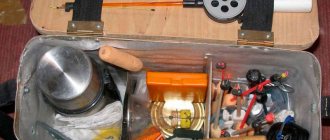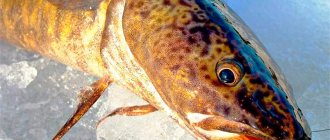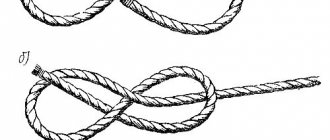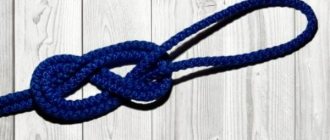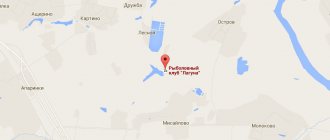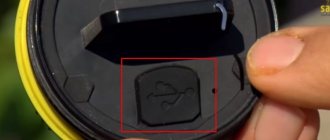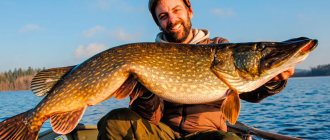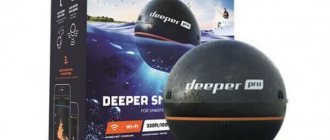Paanajärvi National Park is located in the northern tip of the Republic of Karelia on the border with Finland. Among the expanses of water available to fishermen, part of the lakes Paanajärvi and Pä, the Olanga River, as well as a number of closed forest lakes, called “lambins” in these places, are located on its territory.
The Park's reservoirs are home to whitefish and salmon species: brown trout, trout, whitefish, grayling, and vendace. Perch, roach, pike, burbot, and ide are ubiquitous. Lake Paanajärvi is home to a local form of smelt. The main food supply of predators is variegated goby, minnow, and vendace.
As a result of regular summer fishing expeditions to these places for 20 years, this review appeared.
Let me make a reservation right away - in the Park, in addition to fishing, there are simple entertainments such as hiking along ecological trails, climbing mountains, visiting waterfalls and boat rides. But, to save time, we will not touch on these issues.
Just keep in mind that there will also be activities for those who love environmental activities. Therefore, a trip to the Park can be considered as a joint family vacation. Although, if you take responsibility for family members who do not share the fishing passion, you first need to think carefully.
What to consider before traveling to Paanajärvi
Let's start right away with objective difficulties. The first thing the trip begins with is ordering days of stay at a tent site or in huts. The difficulty is that booking a visit begins on certain days by phone, as well as through the official website.
Due to the popularity of the place, sometimes it is not possible to get through by phone on the first day, and when this does happen, the required dates are already taken. The application is also not immediately verified through the website.
Therefore, when planning a two-week vacation, you can either not select the planned vacation days, or end up booking them in different places of the Park and roaming like a gypsy with your belongings around the tent sites and houses. You just need to be prepared for this.
The fishing season in the Park is limited. Fishing is allowed on the river from June 15 to August 15; the lakes, with the exception of the period of official spawning ban, are open all year round. On the Olanga River, limited areas are reserved for fishing; going outside with gear is considered poaching with the ensuing consequences.
Lake Paanajärvi, the most attractive from a fishing point of view, is also not so easy. Going out on the water is allowed on the national park's boats, which costs an additional 3,000 rubles for 6 hours. The import of personal watercraft and motors into the park is prohibited.
When renting, fishing will take place to the inexorable beat of a metronome. This moment is unpleasant, since fish in a reservoir of this type must first be found.
The negative aspects include three types of blood-sucking reptiles - mosquitoes (where would we be without them), midges and biting midges. Thank God, there are no ticks in these latitudes. At the beginning of the summer season, the number of the above insects sometimes simply goes off scale. We, an experienced people, had serious problems with these creatures, which significantly influenced our daily routine.
One good thing is that there are fewer insects on the river - they are blown away by the wind. In the evening, when the temperature drops, they also disappear.
Modern chemicals are suitable as a means of salvation, as well as mosquito nets, which should be recommended more for women and children. Fishing in this thing is uncomfortable. Not only does visibility decrease, but it is also difficult to get through the bushes.
Types of fish and fishing
Lake Paanajärvi is home to trout, whitefish, perch, burbot, pike, vendace, roach, palia, grayling, redfish, bullhead, and minnow. There is no detailed information regarding the habits and behavior of fish on Lake Paanajärvi, but it is worth noting that the lake is very rich in fish. This is explained by the fact that it is located on the territory of a national park and poaching is completely excluded here.
A boat is required for fishing on Lake Paanajärvi; it is important to note that it is prohibited to use your own boats or motors. Also, you won’t be able to just come and fish in Lake Paanajärvi; you need to obtain a permit at the visitor center, where you will also be provided with other necessary information about fishing. Fishing is allowed with spinning rods, fishing rods and float rods.
Reviews and reports about fishing on Lake Paanajärvi are positive. But you should not come here at the very beginning of June - the water at this time can still be cloudy and very cold. Also, you should not count on good fishing if a strong westerly wind blows - in this case, moving around the reservoir will be very problematic. But in general, Lake Paanajärvi is one of the most interesting for fishing in Karelia. Even if you don't catch any fish, you will visit a very beautiful and interesting place.
Lake Paanajärvi
Let's start our story about fishing with the lake, as a simple and familiar place for most fishermen. The species composition of fish that spinning and fly fishing should expect to catch is small. Pike, perch, brown trout, grayling, ide.
There is talk about the presence of palia, but apparently this is a winter trophy. I have never caught this fish in the summer. Despite the simplified species range, fishing on Paanajärvi is exciting.
Pike and perch are especially pleasing. The size of these predators in the lake is impressive. In practice, having an echo sounder and a little knowledge of the reservoir, it is not difficult to find a school of perch of a standard size of 600-700 grams, which will be caught on every cast.
True, there are some specifics that you need to remember when assembling a tube and a box of baits. The celebration will take place on the “shoals” with a depth of 15-32m.
Finding fish on the lake
By the way, about pike in Lake Paanajärvi. It's always interesting with her here. There is a place on the lake called Red Rock. This is a rock formation that is closely adjacent to the water's edge. Accordingly, there is also a cliff under the rock, where our echo sounder, set to 50 m, shows plus infinity.
“Party meetings” of the spotted legion regularly take place here. For some reason, vendace gathers here and serves as a food source for local predators. Pike is not translated here. Several serious fish are taken from one place within 30 minutes, and after a couple of hours you can immediately catch a couple more.
However, this also happens - you arrive, the vendace is present, but the toothy one is skipping - you can break your hands, not a single bite. Apparently there is some kind of northern luck taking place.
If the boat has an echo sounder, but you need to take your own; this device is not included in the rental boat package, then it becomes easier to find fish.
You need to navigate by the schools of vendace, which are clearly visible on the echo sounder. As soon as a flock is discovered, we turn off the engine and fish the square in a fan pattern. The depth of the wiring is not so important, because there can be 60m under the boat. Just cast, gradually fishing at different depths. There are bites even at the surface.
Selection of baits
Lake Paanajärvi is a fault with corresponding depths exceeding the hundred-meter mark. On the coastal shallows you can catch perch of the Moscow region size and the same pike. Serious fish stay at the above-mentioned horizon of 15-32m.
Understanding this, jig heads and spoons need an appropriate weight, for example, 20-30g. Otherwise, fishing will consist of a dull wait for the bait to reach the desired horizon.
A suitable tool would be a 30 gram Kastmeister. This lure can be used with equal success in horizontal and vertical planes. Don't let anyone be confused by the size of the bait and the standard tee - in these places it is necessary to choose reliable gear, since a five-kilogram pike can easily bite between the perches.
For “pelagic” fishing in schools of vendace, the Kuusamo RASANEN spinner is well suited. The bait flies well – if you can avoid its rotation in flight. Probably, the perfectly worked out form has an effect. When falling, it creates multiple axial vibrations, simulating a school of small food fish. When wiring, it oscillates in the desired rhythm and amplitude.
Professor works a little worse, but still effective. Also, a lot of other hardware was tested - in principle it works, my only wish, I repeat, is not to go too small with the size.
A little about wobblers. Over many years of practice, the following trend has become clear - wobblers for pike and perch work better with even wiring. The twitching component, to which the hand is accustomed, often has a negative effect on the result. For some reason, local pike and perch do not like jerky variations. At the same time, brown trout, as far as memory allows, reacts to jerks very aggressively.
Salmon baits
Now we have come to the main lake prize - brown trout. It must be said that at the dawn of the formation of the Park, brown trout lured people to these places. It’s not easy to catch her, whether in a lake or a river. And not because this fish is capricious or cautious. The main strategic task of the fisherman is to hit the bait in the very square meter where this fish is located. And it doesn't happen often.
To be honest, it is impossible to say for sure which bait the trout prefers. The fact is that the bite of this fish sometimes happens only once per trip, and in one person out of eight. Therefore, it is unlikely to be true to say that “today” the brown trout preferred the number four lemon spinner.
One can only list what she was caught with during all this time.
Of course, in the first place will be all kinds of oscillating spoons. This is not because it is the spoons that are best at attracting the attention of brown trout. You can simply fish large spaces quickly with a spoon.
Brown trout were caught both on spinners and wobblers. One catch was recorded using a Manns acid vibrotail of size four. In general, catching this fish is pure fortune, happiness that comes suddenly. Read more about trout fishing in the Park in the article “Fish K”.
Concluding about the lake, I would like to add that Paanajärvi is not a revelation when it comes to fishing. There are places not only closer and cheaper. However, the ambience of the ancient natural lake itself is worth visiting. The water is clean, the shores are picturesque. Fucked up the harsh but beautiful northern country.
Attractions
View from Mount Nuorunen
Mount Nuorunen is a mountain height of 576 meters above sea level. The top of the mountain is flat and offers a panoramic view of the entire territory of the reserve and neighboring Finland.
Mount Kivakkatunturi - another name for the Stone Woman, height 499 meters.
From the mountain there is a view of the Olanga River and the Kivakkakoski rapids, and you can see the Vartiolampi tract. Pyaozero can be seen from the mountain. We recommend: How to get to the city of Ostashkov and get to Lake Seliger from Moscow
Lake Paanajärvi - width 1 km, length 25 km.
Depth 128 meters. Fishing is allowed on the lake with the permission of the administration, and it is also possible to rent a motor boat. The lake is inhabited by grayling, perch, and pike. Kivakkakoski Falls is a 12-meter-high waterfall. On the way to the waterfall is the village of Vartiolampi, in which the life of the Old Believers is recreated.
Olanga River
A small river, even by local standards, connecting lakes Paanajärvi and Pää. Character is fast, mountainous. Although there are areas where the water overflows and the current becomes calm, it is usually the flow and rapids that attract fly fishing and spinning enthusiasts here.
There are designated areas on the river where fishing is permitted. One place, called Vartiyalampi, is a flood, the rest are tied to rapids, of which there are 5 major ones and a couple of minor ones.
If you don’t repeat the fishing spots, then 5 days will be enough for fishing on the river, which will include 5 different sections, consisting of a rapid with the surrounding area.
On Olanga you can catch grayling, perch, pike, brook trout, and brown trout. Sometimes the fish stays in the stream, and not just in the pits and return lines, which gives fishing an original and specific character. The best bait is an oscillating or rotating spoon.
Wobblers are also applicable, but take into account the mandatory percentage of bait losses. If the water is low and the hand is inexperienced, the loss of bait will be noticeable. Therefore, it makes more sense to sacrifice less expensive hardware.
Regarding the water level in Olang. Here, in addition to the normal level, there are two extremes - the water is extremely high and the water is extremely low. Extremes, as we know, are not good.
Firstly, when the water is low, the number of fishing areas decreases significantly. It must be taken into account that not the entire river is accessible to anglers due to areas where fishing is prohibited. Secondly, working with spinners and other spinning baits becomes expensive due to the baits being set.
Fly fishing, sbirulino, regular and Karelian bombard help a little, so in order not to be left out of work in this situation, equip yourself with a minimum set of flies and steamers.
When the water is high, it’s hard to find fish and they don’t take very well. At this time it is better to go to the lakes.
Tactics on the river
There are usually two approaches to fishing on the river. The first is to stay at one point, not moving anywhere. This is often done when fishing for brown trout. This fish is migratory, so it will go against the current somewhere nearby. The method is good if the point is chosen correctly. Usually this is a turn of the river with a return, a bowl of rapids, just a place with an obstacle, for example, a lull behind a large stone.
The fisherman makes himself more comfortable and methodically casts to the same point. Perhaps, if you are only interested in brown trout, this approach is most effective. Although, this strategy is boring and monotonous.
Another fishing option is active movements, changing baits and fishing methods. In this case there will be more grayling, perch and pike. The activity of fish at the points varies, but large and hungry fish, as a rule, are captured on the first casts. Then you wait for a new fish to approach or move on.
Safety
A few words about the technique of movement. The shores, as you have already seen in the photographs, are rocky. Characterizing fishing conditions in this way, we mean three types of “stoniness”. The first one - medium and small cobblestones - is the simplest thing in this story.
The second type is stones, sharp as knives, sticking up. Slippery, dangerous. In this case, it is difficult to move along the shore; increased attention is required. If you need to climb into the water over such stones, think at least three times.
The last, most “fun” thing is large stones. If they are wet or underwater, moving on them will not be easy.
For a long time I resisted the staff that many fishing professionals recommended to me. As I thought, in such conditions, two sticks in my hands was already too much. True, as it turned out later, this is all a matter of habit, and the staff adds convenience and speed.
In addition to the staff, especially for inexperienced fishermen, it is worth advising not to go deep into the water and not to turn your back or chest to the current.
Never neglect the belt that is provided on the waders; be sure to wear your belt. If you accidentally fall into the water, your wading pants may get filled with water. In this case, it will be difficult to get out of the water on your own.
When the waistband is tightened, the waders turn into a float. To be honest, in two decades of visits I have not heard of deaths on Olanga, but I regularly observe people swimming due to self-confidence or simply carried away by their comrades.
The river does not limit the types of fishing. They use spinning, fly fishing, “balda”, sbirulino, bombarda, even a float fishing rod, fortunately, this is not prohibited here.
Fishing on Lake Paanajärvi
There are more than 120 lakes in Paanajärvi National Park. Many are located between low mountain ranges at an altitude of 200-300 meters above sea level. Lake Paanajärvi is located in a gorge that is more than one and a half billion years old! This is the most oxygenated lake in the world! It is distinguished by clean water, which creates a unique microclimate.
You can fish on the lake with a special permit; fishing with nets is prohibited. Thanks to this, the lake is home to many, including unique, species of fish: brown trout, trout, whitefish, grayling, perch, pike, vendace, etc.
Tour program
- Day 1 ◦ Arrival at Louhi station by night or morning trains. Transfer to Pyaozersky village (110 km, 2.5 hours). ◦ Breakfast. Accommodation in the company hostel. ◦ Visit to the Paanajärvi National Park Museum and registration at the visitor center. Transfer by Land Rover Defender or UAZ 390995 to Paanajärvi National Park to the beginning of the trail to Mount Kivakkatunturi (70 km). Climbing Mount Kivakkatunturi (4 km one way). The trail is equipped with wooden boardwalks and rest areas near ponds (streams). Drinking water. After descending from the mountain, we will light a fire and have a snack at the equipped parking lot. ◦ Then we go to our overnight accommodation, located in a cozy place. Hot bathhouse in the evening and swimming in a lake or river if desired. Dinner. Overnight in field conditions (tents).
- Day 2 ◦ Delicious breakfast. Transfer by car to the foot of Mount Pyaynur. On the way, we will stop at the Borovskoye tract, which offers a magnificent view of Mount Pyainur and Lake Tsipringa. View of the mountain from the observation deck. Climbing the mountain along an unprepared route (2 km one way). ◦ Snack in a picturesque place on the shore of a reservoir. Transfer to the Vartiolampi tract (former village). A short hike along a prepared trail to Kivakkakoski Falls will take about 40-50 minutes. ◦ Transfer to the place of overnight stay. Dinner. Bathhouse. Overnight in field conditions (tents).
- Day 3 ◦ We have a quick breakfast and go to meet the pearl of northern Karelia - Lake Paanajärvi! We arrive on the eastern shore of Paanajärvi. Motor boats or a motorized wooden vessel will be waiting for us there. We take with us the necessary things for 6-7 hours of travel. We will visit Red Rocks on the lake. Paanajärvi and Mäntykoski waterfall. ◦ After visiting all the sights, we return back. Dinner. Bathhouse. Overnight in field conditions (tents).
- Day 4 ◦ Late rise. Delicious breakfast, camp preparations. ◦ After this, we slowly get to another unique place that most people simply don’t know about. You will have a unique opportunity to visit the traces of an earthquake that occurred many years ago in the territory of Paanajärvi. A short trek of about two kilometers along a forest path to a tectonic fault. ◦ Transfer to Pyaozersky village.
Included in cost:
✔ three meals a day; ✔ overnight stays in tents; ✔ permits to visit the national park; ✔ support along the route; ✔ rental of watercraft; ✔ instructor's work.
Period: every Thursday from June to September. Duration of the tour: 4 days.
Read completely
How to get there
You can get to Paanajärvi in the following ways:
We recommend: Is it possible to swim and fish on the Vityazevsky Estuary
From Moscow and St. Petersburg , you need to travel by train along the Murmansk Railway. Trains to Loukhi station arrive at night or early in the morning, so tourists may not be able to get on the bus to the village of Pyaozersky and will need to spend the night in a hotel in the village of Loukhi.
By car - along the St. Petersburg - Petrozavodsk - Murmansk highway to the village. Loukhi (distance one thousand kilometers).
From the village of Loukhi - Travel by road to the village of Pyaozersky, the distance is approximately 110 km. There is a bus. 65 kilometers to the village of Pyaozersky is a dirt road.

